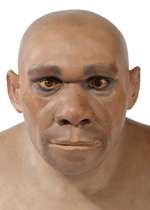Did modern humans eat Neanderthals?

Modern humans may have eaten Neanderthals, scientists report in the Journal of Anthropological Sciences this month.
Scientists carried out a detailed study of jaws and teeth uncovered from the Les Rois cave in south-west France. The site has evidence of a stone and bone tool industry from 35,000 years ago called the Aurignacian, made by some of the first modern humans in Europe, or Cro-Magnons.
Examining jawbones
One of the jawbones was clearly that of a Cro-Magnon child. Another jawbone, also belonging to a child, showed some Neanderthal features in the teeth, such as teeth growth line patterns. It also had cut marks that suggest the tongue was removed, perhaps along with some of the teeth.
Different theories
So the team says this could be evidence that early modern humans in Europe ate Neanderthals, or that they treated the Neanderthal child’s remains in some way, for example as a trophy.
An alternative possibility the team suggests is that there may have been a varied or hybrid population of Cro-Magnons and Neanderthals living together, or the remains may have belonged to Cro-Magnons with more primitive characteristics than normal.
‘Any one of these explanations would be important for our understanding of events in Europe about 35,000 years ago,’ says Chris Stringer, Research Leader in Human Origins at the Natural History Museum.
Sensational evidence?
'But if this site really does have co-existing Neanderthals and Cro-Magnons, it would be sensational evidence in support of one or other of the two leading scenarios for the disappearance of the Neanderthals,' explains Stringer.
Neanderthals
Neanderthals, Homo neanderthalensis, are our best-known extinct relatives. They overlapped with modern humans, Homo sapiens, in Europe between 35-40,000 years ago, disappearing about 30,000 years ago.
Explanations for the disappearance of Neanderthals
One scenario for Neanderthal extinction is that they were replaced by the Cro-Magnons after a period of co-existence and possible interaction. This may have included direct competition between them.
Another scenario is that the Neanderthal and Cro-Magnon populations interbred and blended with each other during their possible co-existence, although many scientists, including Stringer, consider that hybridisation would have been the exception rather than the rule.
Caution needed
However, Stringer says we should not get carried away. ‘We should bear in mind that the tantalising second jawbone bearing cut marks is very incomplete and the authors acknowledge that their identification of it as Neanderthal is only probable, rather than definite.’
More research at Les Rois
There is much more to be uncovered at Les Rois and some of the team will be carrying out more excavations in the future.
‘This will hopefully add finds to help solve the intriguing mystery of the children of Les Rois, their identity, and their fates, both in terms of events 35,000 years ago, and in terms of what they can tell us about human evolution in general, and the fate of the Neanderthals,’ concludes Stringer.
More information: Journal of Anthropological Sciences Vol 87: www.isita-org.com/jass/Contents/ContentsVol87.htm
Source: American Museum of Natural History (news : web)
















